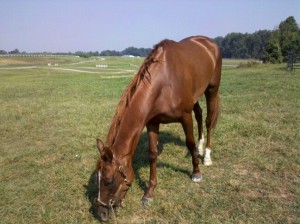According to veterinary studies, between 52 percent and 90 percent of racehorses develop ulcers at some point in their lives.
In this week’s Veterinary Answers column Dr. Bonnie Barr, VMD, DACVIM, of Rood & Riddle Equine Hospital, describes how best to identify and treat the condition.
Dr. Barr is a 1997 graduate of the University of Pennsylvania, receiving her doctor of veterinary medicine, and in 2003 received her Diplomate American College of Veterinary Internal Medicine.
OffTrackThoroughbreds.com, in conjunction with world-renowned Rood &Riddle Equine Hospital, offers a regular Q&A on Veterinary health in order to better understand the physical issues affecting our beloved OTTBs.
Q: How prevalent are ulcers in horses, and specifically ex-racehorses?
Up to 90% of racehorses can have gastric ulcers. A study in the mid-1980’s revealed that 52% of racehorses retired for a month or more had ulcers.
Q: Is stress still considered to be a factor in the condition, and, if so, would a racehorse letting down from the hectic life on a track be any more prone to them than a horse with a more sedentary lifestyle?
Gastric ulcers can result when a horse is placed in an unfamiliar or stressful situation for any length of time. A racehorse letting down might be more prone to gastric ulcers because of a change in surroundings, management and diet. The key to prevention would be to try to make the transition as “stress-free” as possible.
Q: How do ulcers present, in terms of personality and appetite?
Clinical signs associated with gastric ulcers are numerous and often vague. Typical symptoms include poor performance, poor hair coat, picky eating, irritability and colic.
Q: What are the best practices for diagnosis and treatment?
The gold standard of diagnosis is gastroscopy, which is visualization of the stomach with a three-meter endoscope.
The endoscope is inserted through the nose into the esophagus and then into the stomach. The horse is usually held off of feed for some 12 hours, and water for four to six hours prior to the gastroscopy to allow for thorough visualization of the stomach.
If gastroscopy is not an available option, therapy can be started if gastric ulcers are strongly suspected. And if the horse shows improvement with treatment, this result suggests that the horse had gastric ulcers.
The primary goal of treatment is to suppress gastric acid.
The suppression of acid creates an environment conducive for healing.
A lot of products are available for acid suppression. The most commonly used product is omeprazole, which is available under the brand name GastroGard®.
This product blocks gastric acid production at the level of the cells in the stomach.
GastroGard® is given orally once a day for 28 days, and this regimen results in good healing.
Another treatment option is the H2 blockers (ranitidine or cimetidine), which work by blocking one of the hormones that stimulate gastric acid production. However, they are not as convenient to administer because they have to be given multiple times a day for an extended period.
Antacids and gastric protectants can be given, but are not as practical or effective.
Environmental and dietary management, along with pharmacologic therapy, may be beneficial to facilitate ulcer healing.
Management changes include increasing the amount of roughage/forage in the diet, decreasing the amount of grain in the diet and feeding frequent small meals.
Turning the horse out on pasture, and limiting stress, are two other key management practices for treatment and prevention of gastric ulcers.
Those horses that reside inside will benefit from free choice hay in a slow feeder, which can help to mimic grazing behavior.
Gastric ulcers are a result of taking the horse from its natural environment but with common sense management gastric ulcers can be prevented.




This is a very true and great article. I dealt with this in my OTTB and once you just take care of it exactly as the Dr. stated above, it usually doesn’t reoccur. However, I have found that you do have to be careful to watch for signs and treat again should the horse return to it’s new job. This can sometimes flare the stress level up as the horse is trying to discover what it’s new job is. They try to please, and are always trying to figure out what the goal is. Their over achieving personalities make them stress. So, we have to make sure that we recognize this and care for it. This is a good article and will hopefully help others be able to keep their eyes open to this common problem with these wonderful horses. Thank you Susan and Dr.Barr.